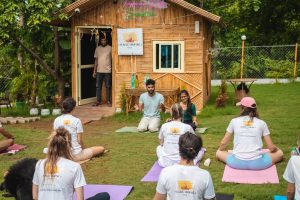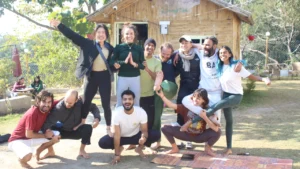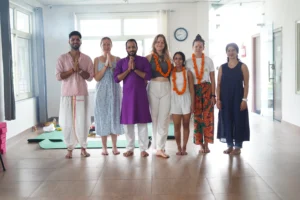Table of Contents
In a world that rarely slows down, quality sleep has become a luxury for many. Racing thoughts, digital distractions, and everyday stressors often keep us wide-eyed long after the lights go out. But what if there was a simple, accessible practice that could guide your body into deep relaxation while keeping your mind gently aware? Enter Nidra Yoga — also known as yogic sleep — a powerful tool for deep rest, inner healing, and rejuvenation.
What Is Nidra Yoga?
Nidra Yoga doesn’t just help you fall asleep; it helps you heal your relationship with rest. Many of us carry subconscious tension, unresolved emotions, or a racing inner dialogue that disrupts our sleep cycles. Nidra gently addresses these layers, allowing your body to let go without force.
Here’s how Nidra Yoga supports restful sleep:
- Calms the nervous system: Activates the parasympathetic state, reducing cortisol (stress hormone) levels.
- Improves sleep quality: Helps with insomnia, fragmented sleep, and night-time anxiety.
- Releases deep-seated stress: Clears mental clutter, making it easier to transition into natural sleep.
- Builds body awareness: Encourages mindfulness of physical sensations, breath, and thoughts, leading to better self-regulation.
Benefits of Yoga Nidra for Sleep
Practicing guided Yoga Nidra before bed or even during the day can dramatically improve your ability to rest and recover. It’s a powerful tool for anyone seeking natural sleep remedies or wanting to add relaxation techniques before bed to their wellness routine.
Here’s how Nidra Yoga supports restful, restorative sleep:
- ✅ Relieves insomnia and anxiety
- ✅ Promotes deep relaxation by activating the parasympathetic nervous system
- ✅ Improves sleep quality and duration
- ✅ Reduces stress and cortisol levels
- ✅ Supports mental clarity and emotional balance
What to Expect in a Session
A typical Nidra Yoga session lasts 20–45 minutes and is suitable for all levels. You’ll lie down comfortably while the teacher guides you through stages like intention-setting (Sankalpa), body scan, breath awareness, and visualization. There’s nothing to “do” — you simply follow the voice and allow your body to relax.
It’s normal to drift in and out of awareness — that’s part of the process. Even if you fall asleep, your subconscious still receives the benefits of the practice.
A typical Nidra Yoga session lasts 20–45 minutes and is suitable for all levels. You’ll lie down comfortably while the teacher guides you through stages like intention-setting (Sankalpa), body scan, breath awareness, and visualization. There’s nothing to “do” — you simply follow the voice and allow your body to relax.
It’s normal to drift in and out of awareness — that’s part of the process. Even if you fall asleep, your subconscious still receives the benefits of the practice.
Nidra Yoga in Our Teacher Training
At Sage House Yoga, we believe that rest is an essential part of holistic wellbeing. That’s why we include Yoga Nidra poses and practices as a key part of our 200-Hour Yoga Teacher Training Course in Rishikesh.
Whether you’re training to become a teacher or simply deepening your practice, you’ll learn:
- The foundations and philosophy of Yoga Nidra
- How to guide others through sessions
- Practical techniques to support stress, trauma, and sleep issues
- Breathwork and body-based relaxation methods
How to Begin Your Nidra Practice
You don’t need any prior experience to get started. All it takes is a quiet space, a comfortable place to lie down, and a willingness to let go. We recommend trying a short guided session before bed, or even during the day to reset your energy.
Over time, your body begins to associate the practice with rest and safety, allowing you to access deeper states of relaxation more easily.
Incorporating Nidra Into Your Routine
You can practice Nidra Yoga before bed as a wind-down ritual or even during the day as a reset. Just one session can feel like hours of deep sleep, making it a powerful supplement for those struggling with chronic fatigue, burnout, or restless nights.
The Science Behind Yoga Nidra and Sleep
Modern research backs what yogis have known for centuries: Yoga Nidra improves sleep quality and reduces stress by regulating the nervous system. Studies show that regular practice can reduce symptoms of insomnia, anxiety, and even PTSD by guiding the brain into theta and delta wave states — the same brainwaves associated with deep sleep and restoration.
Unlike a nap, Yoga Nidra allows the body to rest deeply while maintaining conscious awareness, helping to balance the sympathetic (fight or flight) and parasympathetic (rest and digest) nervous systems.
Start Your Journey
At Sage House Yoga, we offer guided Nidra Yoga sessions designed to meet you exactly where you are. Whether you’re seeking better sleep, stress relief, or simply a moment of peace in your day, this practice offers a gentle, profound pathway inward.








